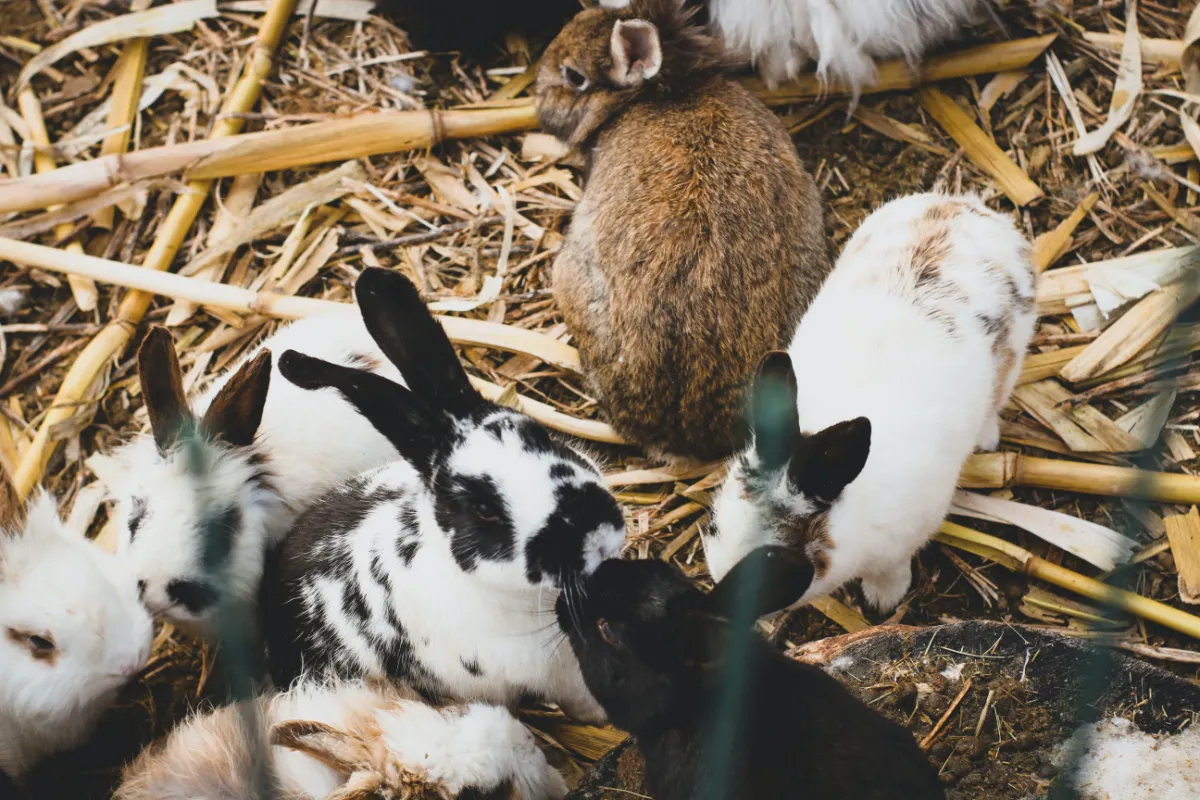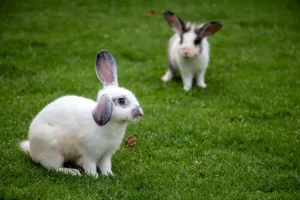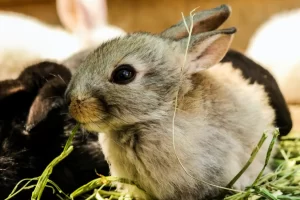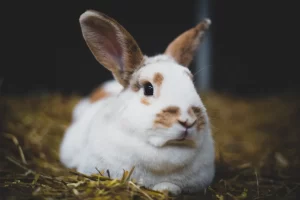Are you tired of sifting through hay, searching for those pesky rabbit droppings? Well, fret no more! In this handy guide, we’ll show you a foolproof method to separate rabbit poop from hay, making your cleaning routine a breeze.
With just a few simple tools and our step-by-step instructions, you’ll have a clean and odor-free hay area in no time. Say goodbye to the mess and hello to a fresh and tidy space for your furry friends!
In This Article
- 1 Key Takeaways
- 2 The Importance of Separating Rabbit Poop From Hay
- 3 Tools and Equipment Needed for Efficient Poop Separation
- 4 Step-By-Step Guide to Separating Rabbit Poop From Hay
- 5 Tips and Tricks for Maintaining a Clean Hay Area
- 6 Common Mistakes to Avoid When Separating Rabbit Poop From Hay
- 7 Frequently Asked Questions
- 7.1 How Often Should Rabbit Poop Be Separated From Hay?
- 7.2 Can Rabbit Poop Be Used as Fertilizer for Plants?
- 7.3 Is It Necessary to Separate Rabbit Poop From Hay if the Hay Is Clean and Odor-Free?
- 7.4 What Are Some Alternative Methods for Separating Rabbit Poop From Hay?
- 7.5 Are There Any Health Risks Associated With Handling Rabbit Poop During the Separation Process?
- 8 Conclusion
Key Takeaways
- Maintaining cleanliness and separating rabbit poop from hay helps prevent health issues and reduces the risk of bacterial growth and diseases.
- Separated rabbit poop can be used as a nutrient-rich fertilizer for gardening, improving soil structure and promoting healthy plant growth.
- The process of separating rabbit poop from hay involves using tools such as a scoop or shovel, a mesh screen or sifter, and a clean container.
- Composting rabbit poop not only reduces waste but also creates a beneficial fertilizer packed with essential nutrients like nitrogen, phosphorus, and potassium.
The Importance of Separating Rabbit Poop From Hay
You should separate rabbit poop from hay to maintain cleanliness and prevent potential health issues.
It’s important to understand the benefits of using rabbit manure as fertilizer in gardening. Rabbit manure is rich in nutrients, such as nitrogen, phosphorus, and potassium, which are essential for plant growth. By separating the poop from hay, you can easily collect the manure and use it to enrich your garden soil. This natural, organic fertilizer can improve soil structure, promote healthy plant growth, and increase crop yield.
Additionally, maintaining clean living conditions for your rabbits is crucial for their health. By removing the poop from the hay, you reduce the risk of bacterial growth and potential diseases. It also helps to keep your rabbits’ living area clean and odor-free.
Tools and Equipment Needed for Efficient Poop Separation
To efficiently separate rabbit poop from hay, you’ll need a scoop or shovel, a mesh screen or sifter, and a clean container to collect the separated poop.
These tools and equipment are essential for achieving efficient separation techniques.
Firstly, a scoop or shovel will allow you to easily gather the hay and poop mixture. Look for a sturdy tool that can handle the weight and volume of the mixture.
Secondly, a mesh screen or sifter will help you separate the smaller poop particles from the hay. Choose a screen or sifter with small enough holes to retain the hay while allowing the poop to pass through.
Finally, a clean container is necessary to collect the separated poop. Ensure the container is easily cleanable and has enough capacity for the amount of poop you expect to separate.
Step-By-Step Guide to Separating Rabbit Poop From Hay
Start by gathering all the necessary tools and equipment, such as a scoop or shovel, a mesh screen or sifter, and a clean container.
Then, follow this step-by-step guide to separate rabbit poop from hay.
First, place a handful of hay onto the mesh screen or sifter and shake it gently. This will allow the smaller particles, including the rabbit poop, to fall through the holes, while the larger pieces of hay remain on top.
Use the scoop or shovel to collect the separated rabbit poop and transfer it into a clean container.
Now, let’s talk about the benefits of composting rabbit poop.
Composting rabbit poop is a great way to create nutrient-rich fertilizer for your garden. It’s packed with essential nutrients like nitrogen, phosphorus, and potassium, which are essential for plant growth.
By composting rabbit poop, you can reduce waste and recycle it into something beneficial.
As for the different methods for disposing of separated rabbit poop, there are a few options.
You can use it directly as fertilizer by spreading it around your plants and garden beds.
Alternatively, you can add it to your compost pile, where it will break down over time and become a valuable addition to your organic matter.
Tips and Tricks for Maintaining a Clean Hay Area
Additionally, it’s important to regularly sweep and remove any excess hay from the hay area to maintain a clean and tidy space. This not only helps prevent wastage but also ensures a healthier environment for your rabbits. Here are some effective ways to prevent hay wastage:
- Use hay racks or feeders to keep the hay off the ground and reduce the chances of it being soiled or trampled.
- Feed smaller portions of hay more frequently to avoid excess hay being left uneaten.
- Consider using hay nets or hay cubes, which can minimize wastage by keeping the hay contained.
- Place a barrier or grate at the bottom of the hay area to catch any falling hay, allowing you to collect and reuse it.
- Provide separate areas for eating and elimination to prevent rabbits from urinating or defecating on the hay.
Now, let’s talk about creative uses for rabbit poop in gardening:
- Rabbit manure is an excellent natural fertilizer due to its high nutrient content.
- Add it to your compost pile to enhance the overall quality of your compost.
- Use it as a top dressing or side dressing for your plants to provide them with a nutrient boost.
- Make a liquid fertilizer by steeping rabbit manure in water for a few days, then dilute it and use it to water your plants.
- Mix rabbit manure with other organic materials to create a nutrient-rich potting mix for seedlings or container plants.
Common Mistakes to Avoid When Separating Rabbit Poop From Hay
You should be careful not to accidentally mix up the rabbit poop and hay when separating them, as this can lead to contamination.
One of the common misconceptions about separating rabbit poop from hay is that it’s not necessary. However, doing so is essential for maintaining a clean and healthy environment for your rabbits.
Rabbit poop, also known as droppings or pellets, can be rich in nutrients and serve as a valuable fertilizer for your garden. On the other hand, hay can contain dust, mold, or other contaminants that can be harmful to your rabbits if ingested.
By separating the two, you can ensure that your rabbits aren’t exposed to any potential health risks. Additionally, keeping the poop separate from the hay makes it easier to clean the rabbit’s living area and prevents the spread of bacteria and odors.
Frequently Asked Questions
How Often Should Rabbit Poop Be Separated From Hay?
To keep your rabbit’s hay clean and fresh, you’ll want to remove the poop regularly. The best way to do this is by using a hay feeder with a built-in grid or shaking the hay to separate the poop. This should be done every day or every other day.
Can Rabbit Poop Be Used as Fertilizer for Plants?
Using rabbit poop as fertilizer has many benefits. It is rich in nutrients and can enhance plant growth. To effectively use it, make sure to compost it first and then apply it to your plants.
Is It Necessary to Separate Rabbit Poop From Hay if the Hay Is Clean and Odor-Free?
Is it necessary to separate rabbit poop from hay if it’s clean and odor-free? Well, using rabbit poop as fertilizer has many benefits. To maintain a clean and odor-free hutch, follow these tips…
What Are Some Alternative Methods for Separating Rabbit Poop From Hay?
To efficiently separate rabbit poop from hay, try alternative techniques. There are various methods you can utilize, such as sifting the hay, using a hay feeder with a grid, or employing a vacuum cleaner designed for small particles.
Are There Any Health Risks Associated With Handling Rabbit Poop During the Separation Process?
When handling rabbit poop while separating it from hay, it’s important to be aware of potential health risks. However, by taking proper precautions and ensuring proper disposal, you can minimize any potential negative effects.
Conclusion
In conclusion, separating rabbit poop from hay is a crucial step in maintaining a clean and hygienic environment for your furry friend. By following the step-by-step guide and using the appropriate tools, you can efficiently separate the poop from the hay and ensure a healthy living space for your rabbit.
Remember to avoid common mistakes and implement the tips and tricks provided to maintain a clean hay area. With these practices, you can ensure a happy and healthy rabbit.
So hop to it and keep that hay area clean!





